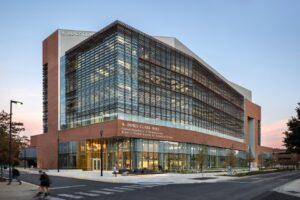
Credit: JeswinThomas / Pexels
Next month, a panel of University of California professors in the sciences and math will give their recommendations on the contentious issue of how much math high school students should know before taking a college-qualifying course in data science. Its answer could influence future course offerings and admissions requirements in math for UC and CSU.
“There’s a tension between the interest in adhering to math standards and ensuring students learn math and also recognizing the changes that are happening in the uses of math in industry and the world in general,” said Pamela Burdman, executive director of Just Equations, a nonprofit that promotes policies that prepare students with quantitative skills to succeed in college.
“How UC resolves this issue will have a bearing on that, and the signals that UC sends to high schools about what is and isn’t approved will have a big impact on what this next generation of students learns.”
The issue has embroiled California’s higher education decision-makers, and it mired proponents and opponents of California’s new TK-12 math framework in an acrimonious debate earlier this year.
Advocates have cited the appeal of introductory data science as a way to broaden the boundaries of math to students who were turned off by it. Traditionalists – STEM professors and professionals – countered that courses like introductory data science that include little advanced math content create the illusion that students are prepared for college-level quantitative work while discouraging them from pursuing STEM majors.
Separate from this immediate question, a second group of UC, CSU and community college math professors is revisiting a more fundamental question: How much math knowledge is essential for any high school graduate with college aspirations, and separately for those interested in pursuing STEM, the social sciences or majors needing few quantitative skills?
For the past two decades, the answer was cut-and-dried — and uniform. The CSU and UC defined foundational high school math as the topics and concepts covered by the three math courses – Algebra I, Geometry, and Advanced Algebra, which is Algebra II — that both systems require students to pass for admission.
With the state’s adoption of the Common Core math standards for K-12 in 2010, the options expanded to include Integrated I, II and III, which cover the same Common Core topics in a different order. Both UC and CSU encourage students to take a fourth year of math, and most do.
The debate has centered on Algebra II. For future science, engineering and math majors, Algebra II is the gateway to the path from trigonometry and Pre-calculus to Calculus, which they must eventually take. But for the majority of non-STEM-bound students, Algebra II can be a slog: difficult, abstract and irrelevant to the college plans.
Despite a general agreement that high school math should be more relatable and relevant, there is intense disagreement on the fix.
New course offerings in the burgeoning fields of data science and statistics “present new ways to engage students. At the same time, they can foster the quantitative literacy — or competency with numerical data — that math courses are intended to provide,” Burdman wrote in a commentary in EdSource. “They have the potential to improve equity and ensure that quantitative literacy is a right, not a privilege.”
But with 17% of Black children, 23% of Hispanic children and 23% of low-income children scoring proficient in the latest Smarter Balanced tests, the need for effective and engaging math instruction must begin long before high school. The new TK-12 math framework, approved in July after multiple revisions and four years of debate, forcefully calls for fundamental changes in math instruction.
“Arguments about what content should be included in high school mathematics fail to acknowledge the elephant in the room: We haven’t yet figured out how to teach the concepts of algebra well to most students,” wrote psychology professors Ji Song of CSU Los Angeles and James Stigler of UCLA in an Edsource commentary.
Committees of faculty senates of both UC and CSU have restated that Algebra II, along with geometry and Algebra I, provide the skills and quantitative reasoning needed for college work, in whatever paths students eventually choose.
“College and career readiness expectations include completion of these sequences or their equivalent that cover all of the Common Core standards,” the CSU Math Council wrote in a January resolution.
But in 2020, the influential UC academic senate, which is authorized to oversee course content for admissions, sent a critical mixed message. In a statement, the Board of Admissions and Relations with Schools or BOARS invited proposals for a broader range of math courses for consideration that would enable students to “complete certain mathematics courses other than Algebra II or Mathematics III in their junior year of high school to fulfill the minimum admissions requirement.” BOARS said it saw the expanded options “as both a college preparation and equity issue.”
Proponents of data science seized the opportunity, launching an end-run around what they perceived to be the inflexibility of math professors to change.
New courses
BOARS oversees policy, but the High School Articulation Unit, a small office in the UC President’s Office, does the evaluating and vetting of the tens of thousands of courses that course developers and high school teachers submit annually for approval. The office began authorizing new data science courses as meeting or “validating” the content requirements of Algebra II and Integrated III. The validation exemption presumed that the new course would build upon concepts and standards that students had covered in previous courses — in this case, Algebra II — or would be covered in the new course.
Subsequently, 368 data science and related courses received approval for 2022-23 and 435 for 2023-24. Nearly all use one of a half-dozen or so data science curricula developed for high schools.
There had been a precedent. As early as 2014, the UC had questionably validated statistics courses as satisfying Algebra II because they cover statistics standards that many Algebra II teachers frequently don’t get to, while not teaching other Algebra II content. However, extending validation to data science is more problematic since California has not established standards for the subject. As a result, there are no guidelines for what standards the courses should be teaching.
A flaw in implementation or policy?
In a detailed Nov. 12 letter to UC regents, Jelani Nelson, a professor of electrical engineering and computer sciences at UC Berkeley and a leading critic of weakening math requirements through course substitution, put the blame not on policy changes but on the course-approval process. An Articulation Unit with a small staff, none of whom had a background in STEM, was overwhelmed, he wrote.
Others agree. Rick Ford, professor emeritus and former chair of the department of mathematics at CSU Chico, said that what once was a rigorous process for course approval had become a “horrendous” pro-forma exercise, “primarily reliant on the fidelity of submitters” to follow BOARS guidelines.
The oldest and most popular course, Introduction to Data Science, developed by UCLA statistics professor Robert Gould through funding from the National Science Foundation and used throughout Los Angeles Unified, covered only the statistics standards, not other content in Algebra II. The same was the case with another popular course validated for Algebra II, “Explorations in Data Science,” developed by YouCubed, a Stanford University research center.
Most students who had taken Introduction to Data Science so far had taken Algebra II, so that was not a problem. But those who took it as juniors in lieu of Algebra II might find the course shut doors instead of opening them. Those who might later decide they want to major in biology, computer science, chemistry, neurology or statistics, all of which require passing Calculus, would find themselves struggling for lack of Algebra II; the CSU, meanwhile, no longer offers remediation courses in math.
“You’re asking a 14- or 15-year-old kid to make a lifelong decision in the spring of sophomore year,” said Ford, who chaired the influential Academic Preparation and Education Programs Committee of the CSU academic senate. “Watering down content is creating a multitrack system instead of giving all students the greatest chance of success.”
A backlash followed
News that UC was approving the substitution of data science for third-year Common Core math frustrated the faculty of CSU, which has relied on BOARS and the UC faculty for policy decisions since the two systems agreed to common course requirements, known as A-G, in 2003. Approving coursework that does not meet Common Core standards “brought to light the complete lack of control that the CSU has over the A-G high school requirements that are used for admission to our system,” the CSU senate stated in a January resolution. It called for the academic senates of both systems “to explore establishing joint decision-making” over new courses and changes to the A-G standards.
In July, during the lead-up to the anticipated approval of the final version of the updated California Math Framework by the State Board of Education, tensions came to a head. Thousands of STEM professionals and UC and CSU faculty had signed petitions sharply criticizing earlier drafts of the math guidelines. The proposed framework had discouraged districts from offering Algebra I in eighth grade, compounding the challenge of taking Calculus before high school graduation, while encouraging students to take data science over STEM professions that were described as less interesting and collaborative. One of the five authors of the drafts was Jo Boaler, a prominent professor of mathematics education at the Stanford Graduate School of Education and co-founder of YouCubed.
In the framework it adopted in July, the State Board of Education left it to districts to decide who should take Algebra in the eighth grade. The final version revised language conflating courses in data literacy, which all 21st-century students need, with math-intensive data science courses that, together with Calculus, would prepare students for a data science major in college. It also dropped a new third pathway for data science next to the traditional pathway leading to Calculus.
But the final framework hasn’t fully mollified critics, including Elizabeth Statmore, a math teacher at Lowell High in San Francisco and former software executive.
“By encouraging students to abandon algebra before they’ve solidified their understanding, the (framework) makes it even more difficult for them to get back on that track — even more so now that our community colleges and CSUs have done away with remedial courses,” she wrote in an email.
“The only way we’re going to diversify STEM fields is to keep historically excluded young students on the algebraic thinking pathway just a little bit longer. That will give them the mathematical competencies they will need to make their own decisions about whether or not they want to pursue rigorous quantitative majors and careers.”
Feeling the heat, BOARS hastily reversed positions on July 7 — days before the State Board meeting — revoking validation for meeting Algebra II requirements for all data science courses. And, in a letter to the State Board, BOARS Chair Barbara Knowlton requested wording changes to the proposed framework, which the board did, including deleting a diagram that showed data science as an option to sub for Algebra II.
“The data science courses that have to date been approved by UCOP’s high school articulation team appear not to have been designed as third- or fourth-year mathematics courses,” wrote Knowlton, a professor of psychology at UCLA.
Ten days later, BOARS met again and clarified that there might be some exceptions for granting validation to those data science courses with “a prerequisite mastery of Algebra II content.” It also reiterated that the revocation of A-G credit would exempt students who are currently taking data science courses, with credit for Algebra II, or who had taken data science courses in past years.
“It’s been unfortunate that UC’s process of determining the rules has caused far more confusion than was needed,” said Burdman, the executive director of Just Equations.
The minutes of the meeting revealed that BOARS members professed they didn’t know how the articulation unit in the President’s Office determined if courses could be substituted. Nor could they determine how many data science courses were designated as advanced math. The President’s Office said about 400 data science courses were being taught in California high schools.
The minutes said that BOARS would appoint a working group, including professors of computer science, neuroscience, statistics and math, to clarify how to enforce the July 7 revocation vote, incorporate Algebra II as a course prerequisite, and determine the criteria for course validation.
BOARS, whose meetings are not public, hasn’t disclosed who’s in the group, although it includes no CSU faculty. The group has been meeting ahead of a December deadline so that BOARS can review and take action in January; only then will its recommendations be made public, Knowlton said in an interview.
There’s pressure to complete work in time for the next course cycle for the fall of 2024, starting in February, so that applicants know the new rules. “There is a concern among some people that if we don’t send this message quickly, there will be a proliferation of these courses,” she said.
Knowlton hopes the work group will identify elements of algebra that are critical for student success and evaluate courses to see which ones don’t cover them.
“Some validated courses may leave out really very important foundational aspects of math, and we want to reiterate what those are,” she said. Course developers could choose to add concepts to qualify for validation for Algebra II; that’s what the developers of financial math have done. Or instead, they could offer courses like data science as advanced math in the fourth year of high school, with a prerequisite of Algebra II.
Knowlton said BOARS is committed to equity in college admissions. But the challenge is balancing access and preparation, she said. “We want as much access as possible, yet it has to mean that students are prepared.”
But Aly Martinez, the former math coordinator for San Diego Unified, is worried that efforts to create innovative and rigorous courses in data science and statistics will be swept aside if BOARS applies restrictions too broadly.
After surveying students about their math interests, the district worked with the creators of CourseKata to turn its college statistics and data science course into two-year high school courses incorporating Algebra II standards and college and career pathway requirements. The courses can lead to Calculus for STEM majors; others can apply the knowledge to social science and other majors. The first-year course is popular and should be validated as satisfying Algebra II, she said.
“There is momentum and excitement about this work,” said Martinez, who is now the director of math for the nonprofit Student Achievement Partners. “Those who are innovative should not be the ones getting hurt.”
A fresh look at standards
The second committee commissioned will take a broader and longer view of math content. Its members will include math professors from the CSU and community colleges, as well as UC, as a math subcommittee of a joint faculty body, the Intersegmental Committee of Academic Senates.
Kate Stevenson, a math professor at CSU Northridge and member of the new workgroup, said, “It’s not our goal to rewrite the standards, but to emphasize what parts of the standards are really critical to all students’ success and which are critical to life sciences as opposed to engineers, physicists and chemists.”
The committee will probably not recommend dropping math standards but could look at reorganizing or de-emphasizing them, she said.
Few Algebra II teachers find time for statistics standards, she said. “So what would a third year look like with a better balance between statistics and algebraic skills? Could we repeat less of Algebra I if we did the integrated pathway?” she asked. “Or what parts of the algebra curriculum could really belong in Pre-calculus rather than in Algebra II?”
Although it is not the role of the committee, Stevenson said she thinks the Common Core standards deserve revisiting. “It’s not that I don’t like the standards. But it’s very unlikely the mathematics that we agreed to in 2013 is the mathematics that we think students should have in 2030.”
Clarification: The article was updated Dec. 15 with the exact number of data science courses that the Articulation Unit of the UC Office of the President approved for 2022 and 2023; they were fewer than the article had implied.






